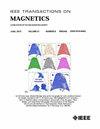Optimization Method Based on Zonal Harmonics for Axially Symmetric Magnets
IF 2.1
3区 工程技术
Q3 ENGINEERING, ELECTRICAL & ELECTRONIC
引用次数: 0
Abstract
An optimization method based on the zonal harmonic description of the magnetic field, suitable for the design of axially symmetric magnetic sources, is presented. Expressions of both axial轴对称磁体分区谐波优化方法
提出了一种适用于轴对称磁源设计的基于磁场区域谐波描述的优化方法。得到磁场轴向分量$B_{z}$和径向分量$B_{\rho}$的表达式,表示为纬向谐波的无穷和。对于以轴向磁化圆柱体为基本构件的排列,也导出了所有纬向动量$M_{l}$的解析公式,直至11阶($l=11$)。通过这些公式建立的关系,启动了优化程序,以找到满足设计期望目标的永磁环排列。给出了两个应用实例:一对环排列(PRA)最均匀的梯度场和四环排列(FRA)最均匀的磁场。针对PRA和FRA两种情况,找到了几种优化配置。对于厚度较薄的PRA,所发现的几何条件再现了产生梯度的已知麦克斯韦电流环路对的几何条件。在上下环间距半径为28%的区域内,这样实现的梯度均匀性达到0.5%。对于间隙为300 mm的FRA配置,报告了7种配置,提供了98.1至82.2 mT之间的场强。在最佳情况下,不均匀性为100 ppm,占间隙的40%。利用有限元分析(FEA)计算出的场强线与通过径向和轴向分量序列表达式计算出的场强线相匹配,证实了所发现的FRA结构符合设计目标。此外,所获得的均匀性与文献中报道的其他轴对称核磁共振成像(MRI)配置的其他设计相比较。然而,所发现的联邦铁路局结构以其更简单的结构而与众不同。讨论了该方法在电子光学或磁致动器磁透镜设计中的应用。
本文章由计算机程序翻译,如有差异,请以英文原文为准。
求助全文
约1分钟内获得全文
求助全文
来源期刊

IEEE Transactions on Magnetics
工程技术-工程:电子与电气
CiteScore
4.00
自引率
14.30%
发文量
565
审稿时长
4.1 months
期刊介绍:
Science and technology related to the basic physics and engineering of magnetism, magnetic materials, applied magnetics, magnetic devices, and magnetic data storage. The IEEE Transactions on Magnetics publishes scholarly articles of archival value as well as tutorial expositions and critical reviews of classical subjects and topics of current interest.
 求助内容:
求助内容: 应助结果提醒方式:
应助结果提醒方式:


